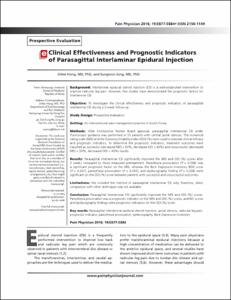KUMEL Repository
1. Journal Papers (연구논문)
1. School of Medicine (의과대학)
Dept. of Anesthesiology & Pain Medicine (마취통증의학)
Clinical Effectiveness and Prognostic Indicators of Parasagittal Interlaminar Epidural Injection
- Alternative Author(s)
- Hong, Ji Hee; Jung, Sung Won
- Journal Title
- Pain Physician
- ISSN
- 2150-1149
- Issued Date
- 2016
- Keyword
- Parasagittal interlaminar epidural steroid injection; spinal stenosis; radicular leg pain; prognostic indicator; paresthesia provocation; epidurography; Beck Depression Inventory
- Abstract
- Background: Interlaminar epidural steroid injection (ESI) is a well-established intervention to
improve radicular leg pain. However, few studies have demonstrated the prognostic factors for
interlaminar ESI.
Objective: To investigate the clinical effectiveness and prognostic indicators of parasagittal
interlaminar ESI during a 2-week follow-up.
Study Design: Prospective evaluation.
Setting: An interventional pain management practice in South Korea.
Methods: After Institutional Review Board approval, parasagittal interlaminar ESI under
fluoroscopic guidance was performed in 55 patients with central spinal stenosis. The numerical
rating scale (NRS) and the Oswestry Disability Index (ODI) (%) were used to evaluate clinical efficacy
and prognostic indicators. To determine the prognostic indicators, treatment outcomes were
classified as successful (decreased NRS ≥ 50%, decreased ODI ≥ 40%) and unsuccessful (decreased
NRS < 50%, decreased ODI < 40%) results.
Results: Parasagittal interlaminar ESI significantly improved the NRS and ODI (%) scores after
2 weeks compared to those measured pretreatment. Paresthesia provocation (P = 0.006) was
a significant prognostic factor on the NRS, whereas the Beck Depression Inventory (BDI) score
(P = 0.007), paresthesia provocation (P = 0.035), and epidurography finding (P = 0.038) were
significant on the ODI (%) score between patients with successful and unsuccessful outcomes.
Limitations: We included the method of parasagittal interlaminar ESI only, therefore, direct
comparison with other techniques was not available.
Conclusion: Parasagittal interlaminar ESI significantly improved the NRS and ODI (%) scores.
Paresthesia provocation was a prognostic indicator on the NRS and ODI (%) scores, and BDI scores
and epidurography findings were prognostic indicators for the ODI (%) score.
- Publisher
- School of Medicine
- Citation
- JiHee Hong and Sungwon Jung. (2016). Clinical Effectiveness and Prognostic Indicators of Parasagittal Interlaminar Epidural Injection. Pain Physician, 19(6), e877–e884.
- Type
- Article
- ISSN
- 2150-1149
- 파일 목록
-
-
Download
 oak-2017-0354.pdf
기타 데이터 / 230.21 kB / Adobe PDF
oak-2017-0354.pdf
기타 데이터 / 230.21 kB / Adobe PDF
-
Items in Repository are protected by copyright, with all rights reserved, unless otherwise indicated.